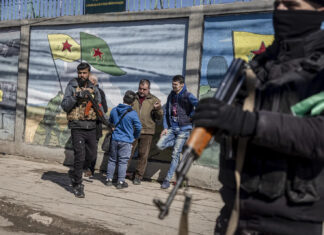
The ongoing conflict between Israel and Hezbollah in Lebanon has triggered a significant exodus of Lebanese citizens, who are now fleeing to Syria for safety. This marks a dramatic reversal of migration patterns, as Lebanon, a country that has long hosted Syrian refugees fleeing their own war, now finds itself sending its people across the border. The situation also involves a strategic redeployment of Hezbollah forces from Syria back to Lebanon, reflecting the intensifying nature of the conflict.
As the Israeli military operation “Arrows of the North” continues to devastate southern and eastern Lebanon, thousands of Lebanese are seeking refuge in Syria. The bombardment, which has already resulted in the deaths of approximately 3,000 people and left thousands more wounded, has driven entire families from their homes. This movement is heavily concentrated at border crossings like Yabous and Josieh, where long lines of vehicles and desperate crowds are becoming the norm.
Local reports indicate that around 2,000 Lebanese crossed into Syria in a single morning, with another 2,000 awaiting entry. This influx is creating severe congestion, particularly at the Jdeidet Yabous crossing near Damascus. Syrian authorities have deployed additional personnel to facilitate the entry process, but the situation remains chaotic as more refugees pour in.
The irony of the situation is not lost on observers. Lebanon has been vocal in recent years about the strain of hosting nearly 1.5 million Syrian refugees, a burden that has exacerbated its economic and social crises. Now, with the tables turned, Lebanese citizens are themselves becoming refugees, seeking safety in a country they once regarded as a source of their own instability.
Simultaneously, the conflict is prompting a significant shift in Hezbollah’s military strategy. The group has begun recalling its elite forces, particularly the “Radwan Unit,” from various theaters in Syria back to Lebanon. This redeployment underscores the seriousness of the threat Hezbollah perceives from the ongoing Israeli military operations.
Hezbollah’s withdrawal from Syria involves a tactical repositioning rather than a full-scale retreat. Fighters are returning through both legal and clandestine routes, with many using border smuggling corridors to avoid detection by Israeli drones. The redeployment is not limited to Syrian-based forces; Hezbollah has also recalled cadres and trainers from Iraq and Yemen, who were involved in drone operations and missile systems management. These specialists are expected to bolster Hezbollah’s capabilities in anticipation of a protracted conflict with Israel.
The redeployment reflects Hezbollah’s broader strategic objectives. The group has not only pulled its forces from Syria but also coordinated with other Iran-backed militias, including those from Iraq, to prepare for joint operations against Israel. The mobilization of these groups, particularly around the Golan Heights and other sensitive areas, signals a potential widening of the conflict that could draw in multiple actors from across the region.
The current wave of Lebanese refugees into Syria is a stark reminder of the cyclical nature of displacement in the region. For over a decade, Lebanon was the destination for Syrians fleeing their war-torn homeland. Now, as the conflict in Lebanon escalates, Syrians are witnessing their former hosts becoming refugees themselves.
This migration underscores the fragility of peace and stability in the Middle East, where borders often become mere lines on a map amid the ebb and flow of conflict. It also highlights the complex interdependencies between countries like Lebanon and Syria, where the impact of war can quickly reverse roles and redefine relationships.
As the situation develops, the international community will need to closely monitor the humanitarian and military dimensions of this crisis. The movement of refugees into Syria and the strategic redeployment of Hezbollah forces are both indicative of a conflict that shows no signs of abating. With regional tensions running high, the implications of this exodus and military buildup could reverberate far beyond the borders of Lebanon and Syria.








